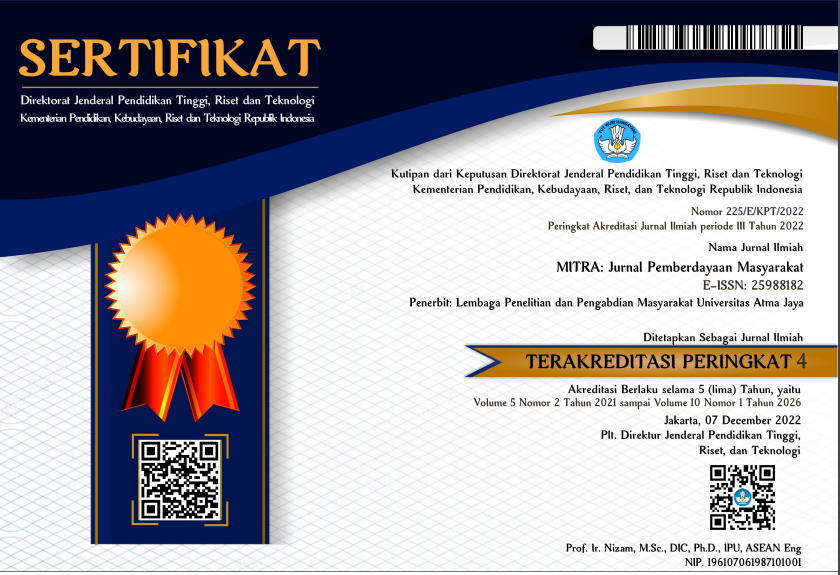Online Training on How to Produce Hygienic Tempeh during the Covid-19 Pandemic
DOI:
https://doi.org/10.25170/mitra.v6i2.2976Keywords:
covid-19, fermentation, pandemic, tempehAbstract
One of the Indonesian government's strategies to control the spread of the Covid-19 virus is to restrict people’s mobility when going out, which is often called the Implementation of Restrictions on Social Activities (PPKM). As a consequence of this PPKM, access to sufficient food tends to be rather limited. One effort to help people meet their food needs was through online tempeh-making training. This training, conducted online using Zoom and WhatsApp groups, involved community members who were connected through several health-related WhatsApp groups. The participants were all Indonesian from various areas, including the Greater Jakarta area, Ambon, Makassar, Medan, Padang, and even the US. Most of them were over 40 years old and were either employees or college graduates. Considering the significance of tempeh as a food item in Indonesia and a relatively affordable source of protein, the training became relevant in helping the participants to produce their own tempeh at home amidst the Covid-19 pandemic. After the training, all participants were found to be able to make tempeh with good quality and hygiene, with several participants even exhibiting creativity in processing their tempeh into more advanced tempeh products, such as tempeh noodles, tempeh pudding, and tempeh steak. In addition, their positive perception of tempeh as a healthy food item increased after attending the training.
References
Ahnan-Winarno, A.D., Cordeiro, L., Winarno, F.G., Gibbons, J., & Xiao, H. 2021. Tempeh: A semicentennial review on its health benefits, fermentation, safety, processing, sustainability, and affordability. Comprehensive Reviews in Food Science and Food Safety. 20(2):1717–1767. DOI:10.1111/1541-4337.12710.
Amin, M.N.G., Kusnadi, J., Hsu, J-L., Doerksen, R.J., Huang, T-C,. 2020. Identification of a novel umami peptide in tempeh (Indonesian fermented soybean) and its binding mechanism to the umami receptor T1R. Food Chemistry. 333:127411. DOI:10.1016/j.foodchem.2020.127411.
Astuti, M., Meliala, A., Dalais, F. S., & Wahlqvist, M. L. (2000). Tempe, nutritious and healthy food from Indonesia. Asia Pacific Journal of Clinical Nutrition, 9(4), 322-325. DOI: 10.1046/j.1440-6047.
Barus, T., Titarsole, N. N., Mulyono, N., & Prasasty, V. D. (2019). Tempeh antioxidant activity using DPPH method: Effects of fermentation, processing, and microorganisms. Journal of Food Engineering and Technology, 8(2), 75-80. https://doi.org/10.32732/jfet.2019. 8.2.75
Bourdichon, F., Casaregola, S., Farrokh, C., Frisvad, J.C., Gerds, M.L., Hammes, W.P., Harnett, J., Huys, G., Laulund, S., & Ouwehand, A. 2012. Food fermentations: Microorganisms with technologically beneficial use. International Journal of Food Microbiology. 154(3):87–97. DOI:10.1016/j.ijfoodmicro.2011.12.030.
Erkan, S.B., Gürler, H.N., Bilgin, D.G., Germec, M., & Turhan, I. 2020. Production and characterization of tempehs from different sources of legume by Rhizopus oligosporus. LWT. 119:108880. DOI:10.1016/j.lwt.2019.108880.
Handajani, Y. S., Turana, Y., Yogiara, Y., Widjaja, N. T., Sani, T. P., Christianto, G. A. M., & Suwanto, A. (2020). Tempeh consumption and cognitive improvement in mild cognitive impairment. Dementia and geriatric cognitive disorders, 49(5), 497-502. DOI:10.1159/000510563.
Hartanti, A. T., Wulandari, Y. R. E., Hutagalung, R. A., & Barus, T. (2018). Sosialisasi tempe sebagai makanan organik dan sehat kepada ibu rumah tangga di kota Tangerang Selatan. MITRA: Jurnal Pemberdayaan Masyarakat, 2(2), 92-103. DOI: https://doi.org/10.25170/mitra.v2i2.103
Hartmann, A.L,, Behrendt, R.A., & Frøst, M.B. 2019. Fermentation as a driver for food innovation. FEMS Microbiology Letters. 366(6). DOI:10.1093/femsle/fnz058.
Hasan, M.N., Sultan, M.Z., & Mar-E-Um, M. 2014. Significance of fermented food in nutrition and food science. Journal of Scientific Research. 6(2), 373–386. DOI:10.3329/jsr.v6i2.16530.
Kustyawati, M. E., Murhadi, M., & Rizal, S. (2020). Vitamin B12 production in soybean fermentation for tempeh. AIMS Agriculture and Food, 5(2), 262-271. DOI: 10.3934/agrfood.2020.2.262
Romulo, A., & Surya, R. 2021. Tempe: A traditional fermented food of Indonesia and its health benefits. International Journal of Gastronomy and Food Science, 26,100413. DOI:10.1016/j.ijgfs.2021.100413.
Roubos‐van den Hil, P. J., Nout, M. J. R., Beumer, R. R., van der Meulen, J., & Zwietering, M. H. (2009). Fermented soya bean (tempe) extracts reduce the adhesion of enterotoxigenic Escherichia coli to intestinal epithelial cells. Journal of applied microbiology, 106(3), 1013-1021. DOI:10.1111/j.1365-2672.2008. 04068.
SNI (Standar Nasional Indonesia) 3144-2015 Tempe kedelai. (2015). Badan Standarisasi
Stephanie, S., Ratih, N. K., Soka, S., & Suwanto, A. (2017). Effect of tempeh supplementation on the profiles of the human intestinal immune system and gut microbiota. Microbiology Indonesia, 11(1),11-17. DOI:10.5454/mi.11.1.2
Stephanie, T.S., Kartawidjajaputra, F., Silo, W., Yogiara, Y., & Suwanto, A. (2019). Tempeh consumption enhanced beneficial bacteria in the human gut. Food Research, 3(1), 57-63. DOI:10.26656/fr.2017.3(1).
Downloads
Published
Issue
Section
License
Copyright (c) 2022 Tati Barus, Rory Anthony Hutagalung, Rianita Pramitasari, Vivitri Dewi, Alfonsus Samuel Satya Pradipta

This work is licensed under a Creative Commons Attribution-NonCommercial-ShareAlike 4.0 International License.
This license allows reusers to distribute, remix, adapt, and build upon the material in any medium or format for noncommercial purposes only, and only so long as attribution is given to the creator. If you remix, adapt, or build upon the material, you must license the modified material under identical terms.



_.jpeg)

.png)
2.png)
.png)
.png)



